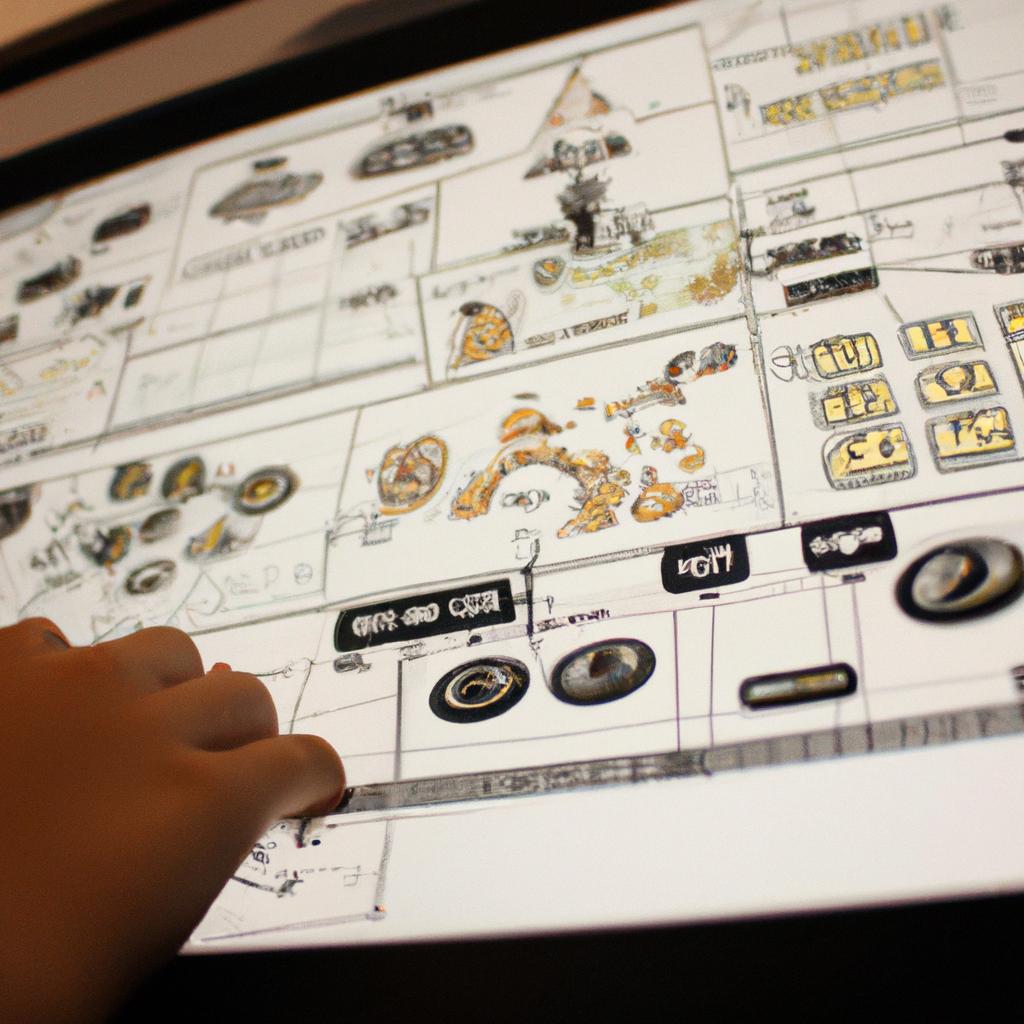Game Balancing: Achieving Fairness and Challenge in Game Design

Game balancing is a critical aspect of game design that aims to achieve fairness and challenge for players. By carefully adjusting various elements within a game, designers can create an experience that is both engaging and enjoyable. For instance, consider the popular online multiplayer game “Fortnite.” In this game, players are dropped onto an island where they must scavenge for weapons and resources while eliminating opponents in order to be the last person standing. If the gameplay were unbalanced, with certain weapons being overpowered or some areas of the map providing unfair advantages, the overall experience would be diminished.
Achieving balance in games involves careful consideration of several factors. Firstly, it requires analyzing player statistics and feedback to identify any imbalances or exploits that may exist within the game mechanics. Once these issues have been identified, adjustments can be made to mitigate their impact and ensure a more level playing field for all participants. Additionally, game balancing entails considering different playstyles and skill levels to ensure that challenges are appropriately scaled. This allows both novice and experienced players to feel challenged without becoming frustrated or disengaged.
In conclusion, game balancing plays a crucial role in creating fair and challenging experiences for players. Through meticulous analysis of player data and thoughtful adjustments to gameplay elements, designers can create games that are enjoyable for a wide range of players. By achieving balance, games like “Fortnite” can provide a level playing field where skill and strategy are the determining factors in success, rather than relying on imbalances or unfair advantages. This ultimately leads to a more engaging and satisfying experience for players, keeping them coming back for more.
Understanding the Importance of Game Balancing
Game balancing is a critical aspect of game design that aims to achieve fairness and challenge for players. When games are properly balanced, they provide an engaging experience by ensuring that no single player or strategy has an overwhelming advantage over others. To illustrate the significance of game balancing, let’s consider a hypothetical example:
Imagine a multiplayer online battle arena (MOBA) game where two teams compete against each other. In this game, there are five different character classes available, each with unique abilities and strengths. However, one particular class called “The Mage” possesses significantly more powerful spells compared to the other classes. As a result, players who choose to play as The Mage have a distinct advantage over their opponents.
In such a scenario, the lack of balance creates an unfair playing field and diminishes the overall enjoyment of the game. Players who do not select The Mage may feel frustrated and discouraged from continuing to play due to the perceived inequality in gameplay mechanics. This demonstrates why achieving proper game balancing is essential for creating an immersive and enjoyable gaming experience.
To further emphasize its importance, here are some key reasons why game balancing should be prioritized in any game design process:
- Player Retention: Balanced games encourage players to continue playing and become invested in the game world.
- Competitive Integrity: Fairness ensures that skillful gameplay determines success rather than exploiting imbalances.
- Positive User Experience: Well-balanced games provide challenging yet achievable goals, leading to increased satisfaction among players.
- Community Engagement: Balanced games foster communities where players can connect, compete, and share experiences in a harmonious environment.
Table 1: Key Reasons for Prioritizing Game Balancing
| Player Retention | Competitive Integrity | Positive User Experience | Community Engagement |
|---|---|---|---|
| Encourages continued engagement | Ensures fair competition | Increases player satisfaction | Fosters a sense of community |
In conclusion, game balancing plays a vital role in creating engaging and fair gaming experiences. By ensuring that no single player or strategy has an overwhelming advantage, balanced games facilitate long-term player retention, maintain competitive integrity, enhance user experience, and foster positive community engagement. In the subsequent section, we will delve into defining fairness in game design.
Transition into the subsequent section: With a clear understanding of why game balancing is crucial, it is important to explore the concept of fairness in game design.
Defining Fairness in Game Design
Section H2: Achieving Fairness in Game Design
Transitioning from the previous section, where we discussed the importance of game balancing, let us now delve into defining what constitutes fairness in game design. To better illustrate this concept, consider a hypothetical scenario involving a multiplayer online battle arena (MOBA) game. In this game, there are different characters available for players to choose from, each with unique abilities and strengths. However, one particular character stands out as being significantly overpowered compared to others.
Fairness is an essential aspect of any well-designed game as it ensures that all players have equal opportunities to succeed and enjoy the experience. When discussing fairness in game design, several key elements come into play:
- Balance: A balanced gameplay environment implies that no single option or strategy dominates over others excessively, thereby allowing for multiple viable approaches and ensuring fair competition among players.
- Accessibility: A fair game should be accessible to players of varying skill levels and experiences, providing new players with a reasonable chance to compete against more experienced ones.
- Progression: The progression system within a game should be designed in such a way that rewards are distributed fairly based on player effort and skill rather than relying solely on random chance or external factors.
- Transparency: Players should have access to clear information about the mechanics of the game, including rules, stats, and parameters affecting gameplay outcomes. This transparency enables informed decision-making and reduces feelings of unfairness stemming from hidden advantages or disadvantages.
| Elements | Description |
|---|---|
| Balance | Ensuring that no single option or strategy overly dominates |
| Accessibility | Providing an opportunity for players at various skill levels |
| Progression | Rewarding player effort and skill instead of randomness |
| Transparency | Offering clear information about the game’s mechanics |
By incorporating these key elements, game designers can strive towards creating a fair and enjoyable gaming experience for all players. In the subsequent section, we will explore how to identify the essential components that contribute to achieving game balance without compromising fairness.
Transitioning into the next section: Identifying Key Elements for Game Balance, it is important to recognize the significance of understanding how different aspects of gameplay interplay in order to create a balanced and fair gaming environment.
Identifying Key Elements for Game Balance
Transitioning from the previous section, which discussed the importance of defining fairness in game design, we now turn our attention to identifying key elements for achieving game balance. To illustrate this concept, let us consider a hypothetical scenario where players engage in an online multiplayer battle arena game. In this particular game, each player controls a unique character with various abilities and attributes.
Achieving game balance requires careful consideration of several factors that contribute to the overall fairness and challenge experienced by players. These factors can be summarized as follows:
-
Character Abilities: Each character should possess distinct strengths and weaknesses that offer tactical advantages and disadvantages during gameplay. This ensures that no single character becomes overpowered or underpowered, creating a balanced playing field for all participants.
-
Resource Management: Games often incorporate resources such as health points, mana, or ammunition that influence decision-making and strategic planning. Balancing resource availability is crucial to prevent any one player from dominating others excessively or running out too quickly, thus maintaining equilibrium throughout the gameplay experience.
-
Level Design: The layout and structure of levels play a significant role in balancing gameplay difficulty. Ensuring fair access to advantageous positions or power-ups while also introducing challenging obstacles creates an engaging experience for all players without favoring certain individuals unfairly.
-
Progression System: A well-designed progression system offers rewards based on skill level rather than solely relying on random chance. By providing meaningful rewards proportional to player performance, it promotes ongoing engagement and motivates players to improve their skills without alienating those who may be less experienced.
To further emphasize the significance of these elements in achieving game balance, consider Table 1 below:
| Element | Importance | Impact | Emotional Response |
|---|---|---|---|
| Character Abilities | High | Significant | Excitement |
| Resource Management | Moderate | Substantial | Frustration |
| Level Design | High | Crucial | Immersion |
| Progression System | High | Influential | Satisfaction |
Table 1: Importance, Impact, and Emotional Response of Key Elements in Game Balance
As shown in Table 1, each element has varying levels of importance and impact on the overall game balance. Understanding these factors enables designers to create an engaging gameplay experience that elicits emotional responses from players.
In summary, achieving game balance requires careful consideration of several key elements such as character abilities, resource management, level design, and progression systems. By ensuring fairness and challenge through well-balanced gameplay mechanics, developers can captivate players and provide an immersive gaming experience. In the subsequent section about balancing difficulty levels for player engagement, we will delve deeper into this topic by exploring strategies to maintain a suitable level of challenge throughout the game.
Balancing Difficulty Levels for Player Engagement
Building on the identification of key elements for game balance, this section will delve into the critical aspect of balancing difficulty levels to ensure player engagement. To illustrate this concept, let us consider a hypothetical example of a puzzle-based mobile game called “Maze Master.”
In the game “Maze Master,” players navigate through intricate mazes by solving puzzles and overcoming obstacles. The objective is to reach the end within a specified time limit while collecting various rewards along the way. Maintaining an optimal difficulty curve is crucial for sustaining player engagement throughout their gameplay experience.
To achieve this delicate balance between challenge and fairness, game designers employ several strategies:
-
Gradual Intensity Progression: As players advance through different levels or stages, gradual increases in complexity ensure a sense of accomplishment without overwhelming them from the start. This progression allows players to familiarize themselves with basic mechanics before introducing new challenges.
-
Adaptive AI Systems: Implementing adaptive artificial intelligence (AI) systems enables games like “Maze Master” to adjust difficulty dynamically based on individual player performance. By analyzing success rates, completion times, or even patterns in decision-making, the AI can calibrate future puzzles accordingly.
-
Clear Game Objectives: Providing clear objectives helps guide player actions and decisions during gameplay. When goals are clearly defined, players have a better understanding of what is expected from them, which contributes to improved focus and motivation.
-
Reward Structure: A well-designed reward structure fosters player motivation and satisfaction as they progress through challenging levels. Incorporating both intrinsic rewards (e.g., unlocking new content) and extrinsic rewards (e.g., virtual currency or achievements) encourages continued play and investment in the game world.
| Difficulty Level | Objective Time Limit | Number of Obstacles | Reward System |
|---|---|---|---|
| Easy | Generous | Few | Frequent and small |
| Medium | Moderate | Increasing | Balanced |
| Hard | Strict | Abundant | Challenging |
Balancing difficulty levels in games is an ongoing process that requires careful consideration of player skill progression, engagement, and enjoyment. By implementing strategies such as gradual intensity progression, adaptive AI systems, clear game objectives, and a well-designed reward structure, game designers can provide players with engaging challenges while ensuring a fair and enjoyable experience.
Understanding the importance of maintaining balance in game design leads us to explore another crucial aspect – the role of feedback mechanics in achieving optimal gameplay experiences.
The Role of Feedback Mechanics in Game Balancing
Building upon the importance of balancing difficulty levels, another crucial aspect of game design is incorporating effective feedback mechanics to enhance player engagement and improve overall game balance.
Feedback mechanisms play a vital role in ensuring that players have a clear understanding of their progress, enabling them to make informed decisions and adjust their strategies accordingly. For example, consider a hypothetical scenario where a player is navigating through an intricate maze in a puzzle-based adventure game. As they encounter obstacles or take wrong turns, the game provides visual cues such as subtle hints or color changes in the environment to guide them towards the correct path. This immediate feedback helps maintain player motivation by preventing frustration caused by getting stuck for prolonged periods.
To further highlight the significance of feedback mechanics, let us explore four key reasons why they contribute to achieving fairness and challenge in game design:
- Motivation: Effective feedback systems can motivate players by acknowledging their achievements promptly. Whether it’s earning experience points after completing quests or receiving virtual rewards for reaching milestones, these positive reinforcements create a sense of accomplishment and encourage continued engagement.
- Learning Opportunities: Well-designed feedback mechanisms provide valuable learning opportunities within games. By providing constructive information about mistakes made or areas needing improvement, players can adapt their gameplay strategies and develop new skills. This iterative process not only enhances their gaming experience but also fosters personal growth.
- Balancing Difficulty Levels: Feedback mechanics help developers fine-tune difficulty levels based on player performance data. By analyzing metrics like completion time, success rate at various stages, or average number of attempts needed to overcome challenges, designers gain insights into potential imbalances and can tweak elements such as enemy strength or puzzle complexity to ensure an optimal level of challenge.
- Player Agency: Effective feedback empowers players with agency by giving them control over their progression. By clearly communicating how specific actions impact outcomes, gamers feel more invested in the game world. This sense of agency cultivates a deeper connection with the gameplay experience and increases overall satisfaction.
To further illustrate how feedback mechanics contribute to game balancing, consider the following table highlighting different types of feedback mechanisms used in popular games:
| Feedback Mechanism | Description | Example Game |
|---|---|---|
| Achievement Unlocks | Unlockable rewards for completing specific objectives or milestones | The Elder Scrolls V: Skyrim |
| Dynamic Difficulty Adjustment | Automatically adjusts difficulty based on player performance | Celeste |
| Progress Indicators | Visual or numerical representation of progress towards goals | Minecraft |
| Leaderboards | Ranking system that compares players’ scores against others | Fortnite |
By incorporating these various feedback mechanics strategically, developers can create engaging experiences that strike a balance between fairness and challenge. In doing so, they foster an environment where players feel motivated, continuously learn, and have control over their progression.
Transition sentence into subsequent section about “Strategies for Achieving Fairness and Challenge in Game Design”: With a strong understanding of the role feedback mechanics play in game balancing established, it is now essential to explore strategies that designers can employ to achieve both fairness and challenge in their game designs.
Strategies for Achieving Fairness and Challenge in Game Design
Building upon the understanding of feedback mechanics, this section will explore several strategies that game designers can employ to achieve fairness and challenge in their game designs. To illustrate these strategies, let us consider a hypothetical example of an online multiplayer shooter game.
One effective strategy is to implement a matchmaking system that ensures players are matched with opponents of similar skill levels. This helps create fair gameplay experiences by preventing highly skilled players from dominating less experienced ones. By analyzing player data such as win-loss ratios or performance metrics, the matchmaking algorithm can intelligently pair individuals based on their abilities. This promotes balanced competition and reduces frustration caused by overwhelming skill disparities.
Another approach is to introduce dynamic difficulty adjustment mechanisms within the game. These systems adapt the level of challenge according to individual player performance, ensuring that players consistently face appropriate difficulty curves throughout their gaming experience. For instance, if a player repeatedly fails at a particular task, the game could automatically lower its difficulty level or provide additional hints to aid progress. Conversely, if a player consistently succeeds without much effort, the game could ramp up challenges to maintain engagement.
To further enhance fairness and challenge, incorporating randomness into certain aspects of gameplay can add excitement and unpredictability. Randomized item drops or unpredictable enemy behavior can keep players on their toes and prevent repetitive patterns from emerging. However, it is crucial for designers to strike a balance between randomness and predictability; too much randomness may lead to frustration while too little might make the game predictable and dull.
In summary, achieving fairness and challenge in game design requires careful consideration of various strategies. Implementing matchmaking systems based on skill levels can ensure balanced competition among players. Dynamic difficulty adjustments help tailor challenges to each individual’s capabilities, maintaining engagement without causing excessive frustration or boredom. Lastly, judicious incorporation of randomness adds excitement while avoiding monotony in gameplay experiences.
| Strategies for Achieving Fairness and Challenge | Description | Benefits |
|---|---|---|
| Matchmaking systems | Pairing players with similar skill levels | Promotes balanced competition |
| Dynamic difficulty adjustment | Adapting challenge based on individual performance | Maintains engagement without frustration |
| Incorporating randomness | Adding unpredictability to gameplay | Enhances excitement and prevents repetitive patterns |
Through the implementation of these strategies, game designers can create captivating experiences that provide both fairness and challenge for players. By employing matchmaking systems, dynamic difficulty adjustments, and incorporating controlled randomness, games can offer engaging interactions tailored to each player’s abilities while avoiding monotony or extreme frustrations.









